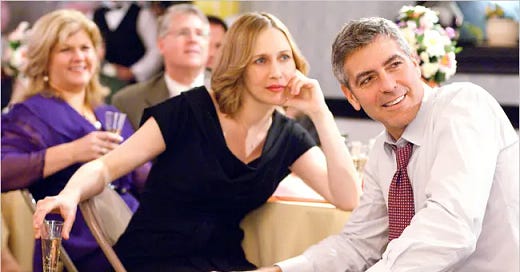The Art of Goodbye and The Theater of Seperation
The movie that taught me how to win at airports and packing for a trip
The genius of "Up in the Air" lies not in its portrayal of corporate downsizing, but in using it as a canvas to explore the broader human choreography of separation. Ryan Bingham, played with precise emotional calibration by George Clooney, isn't just a termination specialist – he's an architect of endings, a professional goodbye-sayer who has turned personal distance into both art and armor.
The Deeper Layers:
The Ritual of Release: What Bingham understands, and what the film gradually reveals, is that every separation requires a performance. Not of insincerity, but of structure. His seemingly cold approach – the precise scripting, the measured tone, the carefully chosen setting – isn't about minimizing emotion, but about creating a container strong enough to hold it. Like a surgeon's sterile field, this ritualization isn't the opposite of care, but its prerequisite.
The Mirror Effect: The film's masterful parallel between professional and personal separations (Bingham's casual relationships, his sister's wedding, his protégé's disillusionment) suggests that all goodbyes follow similar emotional physics. The skills that make Bingham excellent at firing people – clarity, directness, finality – are precisely what most of us avoid in our personal separations, often to everyone's detriment.
The Backpack Theory: Bingham's motivational speech about emptying one's backpack of relationships and possessions isn't really about celebration of emptiness – it's about the illusion of control. His theory collapses not because it's wrong, but because it's incomplete. The backpack fills itself whether we choose to acknowledge it or not.
The Professional's Paradox: The film's core irony? The more skilled you become at handling difficult moments, the more those skills can become a barrier to genuine connection. Bingham's expertise in endings has made him a novice at beginnings and middles.
The Natalie Arc: What appears as a mentorship story is actually a mirror: Natalie's journey from digital-age efficiency to human messiness isn't about learning the "right" way to fire people – it's about understanding that there is no right way. Her breakdown during a video-firing session isn't failure, it's enlightenment.
The Ultimate Insight: The film suggests that our modern obsession with "clean" endings – whether in firing employees, ending relationships, or any other separation – is based on a fundamental misunderstanding. The goal isn't to make the separation painless (impossible) or efficient (inhuman), but to make it meaningful. To acknowledge that every ending is also a story about what was, and what might have been.
Bingham's journey isn't from emotional distance to connection, but from seeing separation as a technical challenge to understanding it as a fundamentally human moment. The skill isn't in avoiding the mess of human emotion, but in creating a space where that mess can exist without overwhelming the necessary outcome.
The film's final scenes, with Bingham returning to the air, suggest that mastery of separation isn't really about learning to let go easily.
But about learning to carry the weight of all our goodbyes while still being able to move forward.




